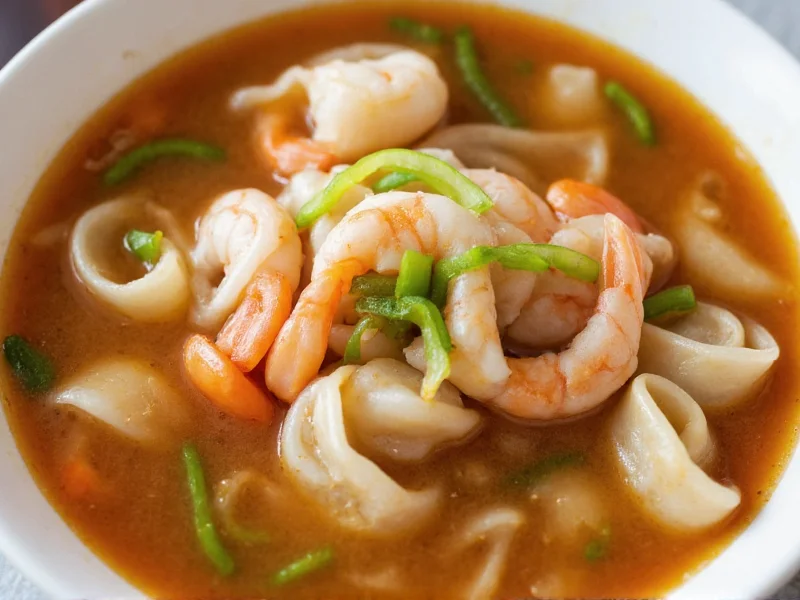The Cultural Roots of Shrimp Wonton Soup
Shrimp wonton soup traces its origins to Guangdong province in southern China, where wontons ("clouds" in Cantonese) have been a culinary staple for centuries. The Cantonese version, known as huntun, traditionally features a delicate shrimp filling that showcases the region's coastal abundance. Unlike northern Chinese wontons that often contain pork, the southern variation highlights seafood, reflecting local fishing traditions.
When Chinese immigrants brought this dish to America in the late 19th century, shrimp wonton soup evolved in Chinatowns across the country. American adaptations sometimes incorporate ground pork into the filling or add bok choy to the broth, but purists maintain that authentic shrimp wonton soup should feature only shrimp in the filling and a clear broth.
Essential Ingredients for Perfect Shrimp Wonton Soup
The magic of homemade shrimp wonton soup lies in ingredient quality and proper technique. Here's what you need for each component:
| Component | Key Ingredients | Why They Matter |
|---|---|---|
| Wonton Filling | Fresh shrimp, ginger, green onions, sesame oil | Fresh shrimp provides sweet flavor and springy texture; ginger cuts through richness |
| Broth Base | Pork bones, chicken carcass, ginger, scallions | Pork bones create rich collagen; chicken adds depth without overpowering |
| Finishing Touches | Shaoxing wine, white pepper, fresh cilantro | Wine enhances umami; white pepper adds subtle heat without color |
Step-by-Step Preparation Guide
Creating authentic shrimp wonton soup requires attention to detail at each stage. Follow these steps for restaurant-quality results at home:
Preparing the Broth (2-3 hours)
Start with 1 pound pork bones and 1 chicken carcass. Blanch them in boiling water for 5 minutes to remove impurities, then rinse. Place in a large pot with 3 quarts cold water, 1-inch ginger slice (smashed), and 2 scallions. Bring to a gentle simmer (never a rolling boil) and skim foam regularly during the first 30 minutes. Simmer uncovered for 2-3 hours until the broth reduces by one-third and turns a light golden color. Strain through cheesecloth for crystal-clear results.
Making the Shrimp Filling (20 minutes)
Peel and devein 1 pound fresh shrimp, then pulse in a food processor until coarsely chopped (not pureed). Transfer to a bowl and mix with 1 tablespoon finely grated ginger, 2 chopped scallions, 1 teaspoon sesame oil, 1/2 teaspoon sugar, and 1/4 teaspoon white pepper. The key to perfect shrimp wonton filling texture is keeping the shrimp cold and avoiding over-processing.
Folding Wontons Properly (30 minutes)
Place a wonton wrapper on a clean surface. Add 1 teaspoon filling in the center. Moisten edges with water, then fold diagonally into a triangle. Press out air pockets and pinch edges tightly. For the classic 'nurse's cap' shape, bring two opposite corners together and seal with water. Proper sealing prevents filling leakage during cooking.
Assembling the Soup (10 minutes)
Bring the strained broth to a gentle simmer. Add wontons and cook for 3-5 minutes until they float and the filling turns opaque. Stir in 1 tablespoon Shaoxing wine and adjust salt as needed. For the authentic presentation, serve immediately in pre-warmed bowls with wontons submerged in clear broth, garnished with fresh cilantro.
Regional Variations Worth Trying
While traditional Cantonese shrimp wonton soup maintains a clear broth and simple filling, regional adaptations offer interesting twists:
- Singaporean style: Features a slightly sweet broth with rock sugar and includes minced pork in the filling
- Hong Kong cafe version: Served with thin egg noodles and a splash of black vinegar on the side
- California fusion: Incorporates cilantro in the filling and serves with chili oil for dipping
- Homestyle American Chinese: Often includes bok choy and uses store-bought wonton wrappers
Pro Tips for Perfect Shrimp Wonton Soup Every Time
Seasoned chefs emphasize these critical techniques for authentic results:
- Keep ingredients cold: Chill the shrimp filling before wrapping to maintain texture
- Never boil the broth: A gentle simmer preserves clarity; boiling makes it cloudy
- Use fresh wonton wrappers: Dried-out wrappers crack when folding; look for pliable, moist sheets
- Cook wontons in batches: Overcrowding lowers water temperature and causes sticking
- Season broth at the end: Salt concentration changes as liquid reduces during simmering
Serving and Storage Recommendations
Serve shrimp wonton soup immediately after cooking for the best texture. The wontons continue cooking in the hot broth, so timing is crucial. Traditional presentation uses deep bowls with wontons fully submerged in broth, garnished with fresh cilantro sprigs.
For storage, keep components separate: broth lasts 4 days refrigerated or 3 months frozen; uncooked wontons freeze well for up to 2 months (place on a parchment-lined tray first, then transfer to containers once frozen). Never freeze cooked wontons as they become mushy.
Troubleshooting Common Issues
Even experienced cooks encounter these shrimp wonton soup challenges:
- Cloudy broth: Caused by boiling instead of simmering; fix by straining through cheesecloth
- Leaking wontons: Usually from insufficient sealing or overfilling; use less filling and press edges firmly
- Tough filling: Results from over-processing shrimp; chop by hand for better texture
- Bland broth: Add a small piece of dried scallop while simmering for natural umami boost
Final Thoughts on Perfect Shrimp Wonton Soup
Mastering shrimp wonton soup requires balancing simplicity with precision. The dish's elegance comes from quality ingredients and careful technique rather than complexity. Whether you're making traditional Cantonese-style soup or experimenting with regional variations, remember that the best shrimp wonton soup features tender wontons that float gracefully in a clear, aromatic broth that tastes like it simmered for hours—even if you've perfected a time-saving method. The key is respecting the fundamentals while adapting to your kitchen's realities.











 浙公网安备
33010002000092号
浙公网安备
33010002000092号 浙B2-20120091-4
浙B2-20120091-4